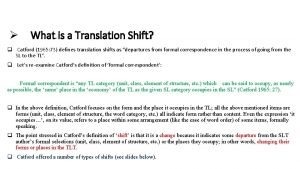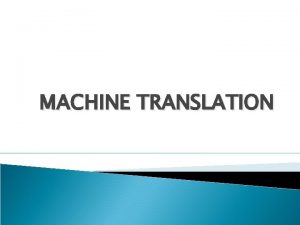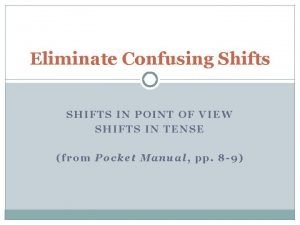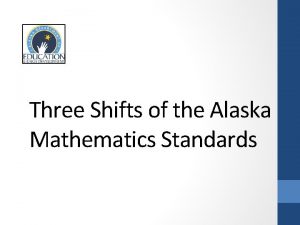Meeting 10 TRANSLATION SHIFTS Types of Translation Shifts









- Slides: 9

Meeting 10 TRANSLATION SHIFTS

Types of Translation Shifts Level Shifts Category Shifts

1. Level Shift A shift of level means that a SL item at one linguistic level has a TL translation equivalent at a different level. Translation between the levels of phonology and graphology—or between either of these levels and the levels of grammar and lexis—is impossible. Translation between these levels is absolutely ruled out by our theory, which posits 'relationship to the same substance' as the necessary condition of translation equivalence. 2. Category Shift a). Structure-shifts, these are amongst the most frequent category shifts at all ranks in translation; they occur in phonological and graphological translation as well as in total translation. In grammar, structure-shifts can occur at all ranks. Structure-shifts can be found at other ranks, for example at group rank.

b). Class-shifts. Following Halliday, Catford defines a class as 'that grouping of members of a given unit which is defined by operation in the structure of the unit next above'. Class-shift, then, occurs when the translation equivalent of a SL item is a member of a different class from the original item. Because of the logical dependence of class on structure (of the unit at the rank above) it is clear that structure-shifts usually entail classshifts, though this may be demonstrable only at a secondary degree of delicacy. Example: güzel bir kız (adj. +noun = pre-positional adj. ) - una chica linda (noun+adj. =postpositional adj. )

c). Intra-system shift. In a listing of types of translation-shift, one might expect 'system-shift' to occur along with the names of the types of shift affecting the other fundamental categories of grammar—unit, structure and class. Example: Singular-plural system is common in Turkish and English BUT English Turkish advice = tavsiyeler sheep = koyunlar

d). Unit-shift. By unit-shift Catford’s mean changes of rank— that is, departures from formal correspondence in which the translation equivalent of a unit at one rank in the SL is a unit at a different rank in the TL. Example: SL lexical item phrase = no TL equivalence, then translated by a uyanmak = wake up nachaltig = for a long time

Exercises After the students read and understand the translation equivalence and translation shift, do some exercises below: (Identify these data SL into TL, whether it is formal or dynamic) 1. 2. 3. 4. SL : Don’t call her that, Ron. I’m really glad you’re taking her, Harry, she’s so excited TL : Jangan memanggilnya begitu, Ron aku benar-benar senang kau mengajaknya Harry dia gembira sekali SL : Don’t drink that, Ron TL : jangan minum itu, Ron SL : I hope you’re not tired of diving into other people’s memories for they’re curious recollections TL : kuharap kau tidak bosan masuk ke dalam kenangan orang lain, karena ini kenangan yang aneh SL : pass me a bowl TL : Ambilkan mangkok

(Identify these data SL into TL based on translation shift) 1. SL TL 2. SL TL 3. SL TL 4. SL TL 5. SL TL : she is eating : ‘Dia sedang makan’ : Your message has been sent : Kami telah mengirim pesan anda : After that, I walked her home : Setelah kami berbelanja, aku mengantarnya pulang : His father is very nice : Ayahnya sangat baik : People often think negative about him : Orang sering berpikir negatif tentang dia

(Identify these data SL into TL based on translation shift) 1. SL : I wouldn’t go in the kitchen just there is a lot of phlegm around TL : mendingan jangan ke dapur sekarang ada banyak dahak 2. SL : it’s my wish that you takeprivate lessons with me this year TL : aku berharap kau belajar private denganku tahun ini 3. SL : Don’t be stupid, you don’t need to try out I’ve watched you play for five years TL : jangan bego, kau tak perlu ikut uji coba aku sudah melihatmu bermain selama 5 tahun

















